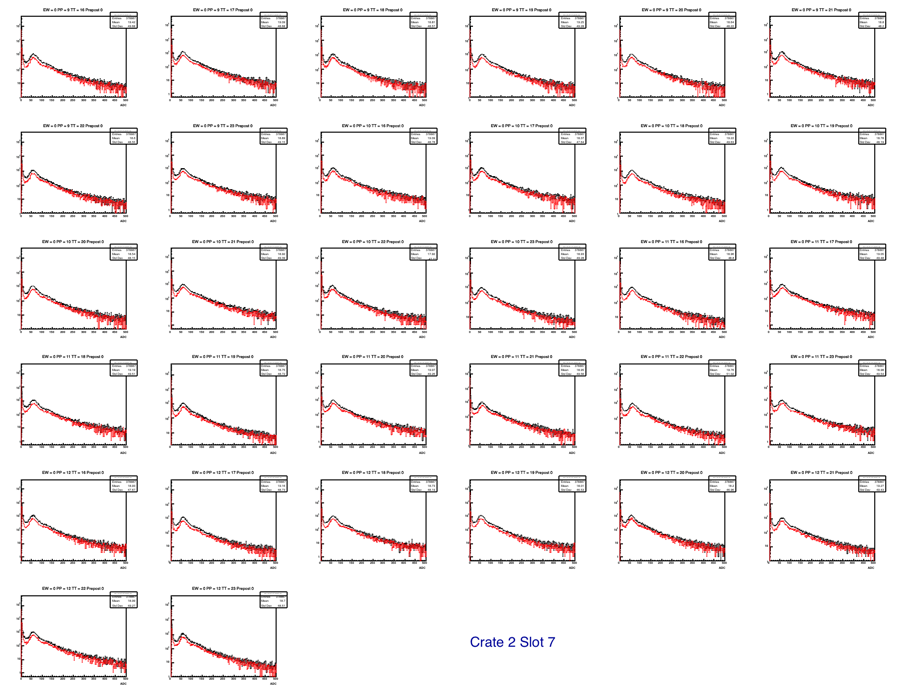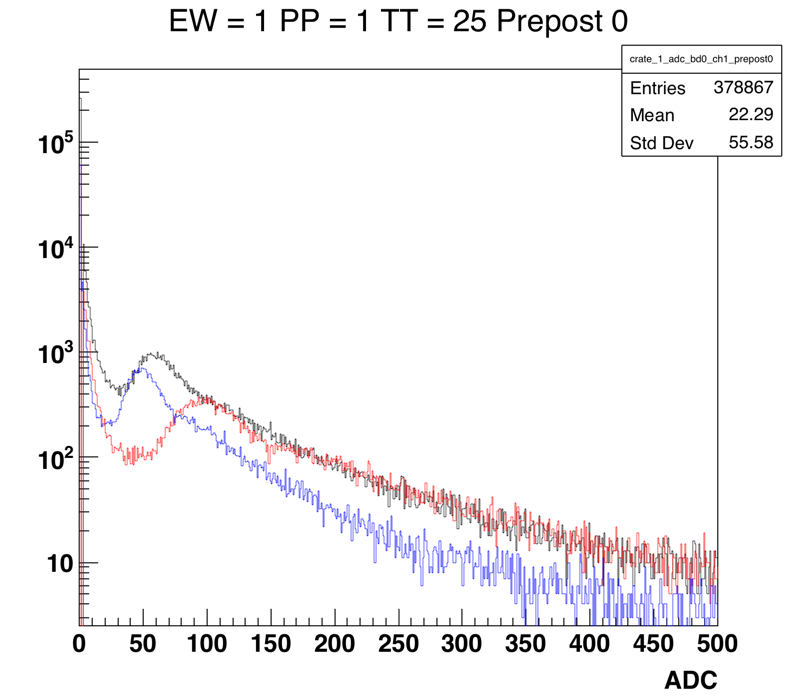The root of the "low gain" problem in QT32Bs at the beginning of run 2019
Updated on Wed, 2019-02-27 10:58. Originally created by lisa on 2019-02-26 23:52.
It has been well documented (e.g. here and on the EPD and trigger lists) that the QT32Bs are producing MIP peaks that are roughly two times lower than they used to be, while we are pretty sure that (1) the gate is correctly timed and (2) the analog signal size is about the same.
At the trigger meeting on 26 Februrary, Eleanor and/or Chris suggested that perhaps this might be related to a new algorithm that was loaded/implemented this year. It was proposed to do a test with one crate returned to the configuration it had in 2018. Jack did the reconfiguration of EQ1 and took data as run 20057041. Here, I compare the ADC spectra with those of run 20057013, which has the new 2019 algorithm.
Rosi spun through the data to make the ADC spectra, and here I am just comparing them.
An unfortunate complication in this comparison is that the bias voltages on 24 tiles was changed (by me) in-between these two runs. In the figures that follow, I have drawn spectra for these tiles on a grey background, so you can just ignore those.
Here, I compare the ADC spectra from these two runs, as seen by the QT32Bs in EQ1 and EQ2. (Slots 0,1,3,4,6,7).
Bottom line: Absolutely the algorithm/configuration is the culprit. All of the QT32Bs in Crate 1 changed, and none of the QT32Bs in Crate 2 changed.
The full spectrum comparison is attached to the bottom of this page, or click here. Below are two pages from it.

Figure 1 - ADC spectra from runs 20057013 (in black) and 20057041 (in red), as seen in the QT32B in slot 7 of EQ1. The red spectra are with the 2018 algorithm loaded. The spectra on grey background are for tiles whose bias changed in the middle of this test, so they should be ignored.

Figure 2 - ADC spectra from runs 20057013 (in black) and 20057041 (in red), as seen in the QT32B in slot 7 of EQ2. The algorithm loaded for this crate was the same in both runs, so the purpose of this figure is simply to verify that the two runs have the same spectra. I.e. that the changes seen in figure 1 are due to the algorithm change.
To first order, this issue appears to be "only" a gain change. But is that all it is? Below see figure 3 with three curves.
The black one is from run 20057013, which has the "new 2019" algorithm.
The red one is from run 20057041, which has the "old 2018" algorithm restored to it.
The blue one is where I take the red one and "cut the gain in half" by hand. (It is similar to a Rebin(2).)
Yes, it is true that the "gain difference" between red and black is not exactly half, so the blue curve maybe shouldn't exactly match the black. But the point is that the black spectrum (using the "new 2019" algorithm) is not simply a "lower gain version" of the red spectrum (which comes from the "old 2018" algorithm).
It seems to me that the "new 2019 algorithm" brings down the MIP signal but does NOT bring down the noise (or at least as much).
There is probably a better way to illustrate/quantify this, and perhaps I'm even just confused. But it seems to me quite important to figure it out.

Figure 3. Description is above.
The study in the figure below makes my point more clearly.
.png)
Figure 4. The ADC spectrum for one channel in crate EQ1. Black is from run 20057013, using the 2019 configuration/algorithm. Red is from run 20057041, for which Jack restored the old 2018 configuration/algorithm. Upper Left: raw. Lower panels: The red curve has been re-scaled on the ADC axis, and renormalized veritically.
Figure 4 conveys two things.
Part 1 - The problem is associated with the "new algorithm"
At the trigger meeting on 26 Februrary, Eleanor and/or Chris suggested that perhaps this might be related to a new algorithm that was loaded/implemented this year. It was proposed to do a test with one crate returned to the configuration it had in 2018. Jack did the reconfiguration of EQ1 and took data as run 20057041. Here, I compare the ADC spectra with those of run 20057013, which has the new 2019 algorithm.
Rosi spun through the data to make the ADC spectra, and here I am just comparing them.
An unfortunate complication in this comparison is that the bias voltages on 24 tiles was changed (by me) in-between these two runs. In the figures that follow, I have drawn spectra for these tiles on a grey background, so you can just ignore those.
Here, I compare the ADC spectra from these two runs, as seen by the QT32Bs in EQ1 and EQ2. (Slots 0,1,3,4,6,7).
Bottom line: Absolutely the algorithm/configuration is the culprit. All of the QT32Bs in Crate 1 changed, and none of the QT32Bs in Crate 2 changed.
The full spectrum comparison is attached to the bottom of this page, or click here. Below are two pages from it.

Figure 1 - ADC spectra from runs 20057013 (in black) and 20057041 (in red), as seen in the QT32B in slot 7 of EQ1. The red spectra are with the 2018 algorithm loaded. The spectra on grey background are for tiles whose bias changed in the middle of this test, so they should be ignored.

Figure 2 - ADC spectra from runs 20057013 (in black) and 20057041 (in red), as seen in the QT32B in slot 7 of EQ2. The algorithm loaded for this crate was the same in both runs, so the purpose of this figure is simply to verify that the two runs have the same spectra. I.e. that the changes seen in figure 1 are due to the algorithm change.
Part 2 - Is this "just a gain change?"
To first order, this issue appears to be "only" a gain change. But is that all it is? Below see figure 3 with three curves.
The black one is from run 20057013, which has the "new 2019" algorithm.
The red one is from run 20057041, which has the "old 2018" algorithm restored to it.
The blue one is where I take the red one and "cut the gain in half" by hand. (It is similar to a Rebin(2).)
Yes, it is true that the "gain difference" between red and black is not exactly half, so the blue curve maybe shouldn't exactly match the black. But the point is that the black spectrum (using the "new 2019" algorithm) is not simply a "lower gain version" of the red spectrum (which comes from the "old 2018" algorithm).
It seems to me that the "new 2019 algorithm" brings down the MIP signal but does NOT bring down the noise (or at least as much).
There is probably a better way to illustrate/quantify this, and perhaps I'm even just confused. But it seems to me quite important to figure it out.

Figure 3. Description is above.
The study in the figure below makes my point more clearly.
.png)
Figure 4. The ADC spectrum for one channel in crate EQ1. Black is from run 20057013, using the 2019 configuration/algorithm. Red is from run 20057041, for which Jack restored the old 2018 configuration/algorithm. Upper Left: raw. Lower panels: The red curve has been re-scaled on the ADC axis, and renormalized veritically.
Figure 4 conveys two things.
- The "gain difference" for the MIP peak is not a factor of two, but rather a factor of 1.65. This is just about 80% of 2. And 80% is exactly the gain difference between 2018 and 2019 for the QT32Cs, as seen in figure 6 of this post: https://drupal.star.bnl.gov/STAR/blog/lisa/setting-bias-voltages-or-2019
- It more clearly illustrates what I was trying to say. In particular, not only does the 2019 configuration/algorithm result in reduced gain for the *signal*, the signal *relative to noise* seems worse. It is possible that this is due only to different beam conditions between these two collisions, however.
»
- lisa's blog
- Login or register to post comments
